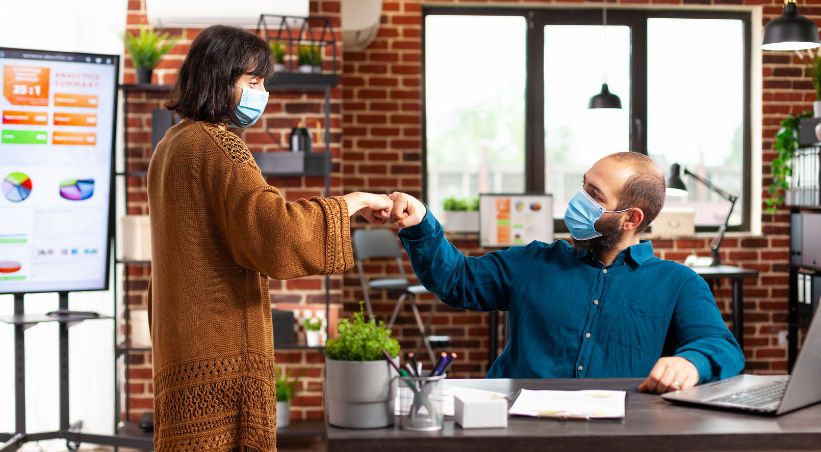We often think of pollution as something that only exists outdoors — near factories, cars, or crowded cities. But here’s a surprising fact: the air inside our homes can sometimes be 2 to 5 times more polluted than outdoor air.
Indoor air pollution can come from many invisible sources — dust, pet dander, smoke, cooking fumes, cleaning products, and even the materials used in your furniture or flooring. Over time, breathing in these pollutants can affect your health, causing allergies, asthma, fatigue, headaches, or respiratory issues.
The good news? You can make your indoor air cleaner, fresher, and healthier with a few simple lifestyle changes. Let’s explore 8 proven ways to improve your air quality at home, along with practical steps you can start applying today.
1. Keep Your Home Clean and Dust-Free
Cleanliness plays a massive role in maintaining good air quality. Dust and dirt accumulate easily on floors, carpets, furniture, and curtains. These particles can contain allergens, mold spores, and even bacteria that you end up breathing in.
Why it matters
When dust settles on soft furnishings like sofas, rugs, and curtains, it continuously releases fine particles into the air. Every time you walk or move around, those particles get stirred up again — leading to poor air quality.
How to do it effectively
- Vacuum regularly — Use a vacuum cleaner with a HEPA filter to capture tiny particles such as pet hair, pollen, and dust mites. Vacuum at least twice a week.
- Mop floors after vacuuming — Vacuuming removes loose dirt, but mopping captures finer dust that vacuums miss.
- Wash bedding and curtains frequently — These fabrics collect skin cells, sweat, and dust. Wash them in hot water every week.
- Declutter your home — Fewer items mean fewer surfaces for dust to settle. Keep tabletops, shelves, and floors as clear as possible.
Regular cleaning prevents buildup and reduces allergens, helping your lungs breathe easier.
2. Bring Nature Indoors with Air-Purifying Plants 🌱
Plants don’t just make your home beautiful — they also act as natural air purifiers. Through a process called phytoremediation, plants absorb toxins from the air and release fresh oxygen.
Why it matters
Common indoor pollutants like formaldehyde, benzene, toluene, and xylene are found in household items like paint, varnish, or furniture. Certain plants can absorb these chemicals and improve your indoor air quality naturally.
Best plants for cleaner air
- Peace Lily: Absorbs mold spores and volatile organic compounds (VOCs).
- Snake Plant (Sansevieria): Works even at night to produce oxygen.
- Spider Plant: Removes carbon monoxide and xylene.
- Aloe Vera: Filters formaldehyde and benzene.
- Areca Palm: Adds humidity and cleans large spaces naturally.
- Boston Fern: Excellent for removing indoor pollutants like formaldehyde.
Care tips
- Avoid overwatering to prevent mold growth in the soil.
- Place plants near sunlight or windows for proper photosynthesis.
- Wipe plant leaves regularly to keep their surfaces clean and effective.
Even adding 2–3 air-purifying plants to each room can make a noticeable difference in air freshness.
3. Ensure Proper Ventilation
Ventilation is key to maintaining a healthy indoor environment. Without proper airflow, pollutants, humidity, and odors can become trapped inside, making your home stuffy and uncomfortable.
Why it matters
Fresh air circulation helps dilute indoor pollutants and reduces the concentration of harmful gases. It also prevents mold growth caused by excess humidity.
How to improve ventilation
- Open windows and doors daily for at least 10–15 minutes.
- Use exhaust fans in kitchens and bathrooms to remove cooking fumes and moisture.
- Install window vents or trickle vents for continuous airflow without letting dust in.
- Keep interior doors open to allow air to move freely between rooms.
If you live in a polluted area, try using an air-to-air exchanger that brings in filtered outdoor air and removes stale indoor air.
4. Use an Air Purifier with HEPA Filter
Air purifiers have become essential in modern homes, especially in urban areas where air quality is often poor.
Why it matters
Air purifiers with HEPA (High-Efficiency Particulate Air) filters can remove up to 99.97% of airborne particles — including dust, pollen, smoke, and bacteria — as small as 0.3 microns.
How to choose the right purifier
- Room size: Always choose a purifier rated for your room’s square footage.
- Filter type: Go for HEPA filters; activated carbon filters are also useful for removing odors and gases.
- Noise level: If you’re placing it in your bedroom, pick a quiet model.
- CADR rating: A higher Clean Air Delivery Rate means faster purification.
Placement tips
- Place the purifier in the most-used area (like your bedroom or living room).
- Keep it 6–12 inches away from walls for better airflow.
- Clean or replace filters regularly (usually every 3–6 months).
Air purifiers are especially helpful for families with children, elderly members, or anyone suffering from allergies or asthma.
5. Maintain Ideal Humidity Levels
Humidity refers to the amount of moisture in the air. Too much or too little can both harm your health and home environment.
Why it matters
- High humidity (above 60%) encourages mold, mildew, and dust mites.
- Low humidity (below 30%) dries out your skin, eyes, and throat.
The ideal indoor humidity level is between 40% and 50%.
How to control humidity
- Use a dehumidifier during humid months or in damp areas like basements.
- Ventilate bathrooms and kitchens to release moisture.
- Fix leaks in pipes, walls, or roofs immediately.
- Use a humidifier during winter when air tends to be dry.
- Monitor humidity using a hygrometer (a small, inexpensive device).
Balanced humidity not only prevents mold but also makes your air purifier work more effectively.
6. Switch to Natural Cleaning Products
Many commercial cleaning agents, sprays, and air fresheners contain chemicals like ammonia, chlorine, and VOCs (volatile organic compounds) that pollute your indoor air.
Why it matters
These chemicals release fumes that can irritate your lungs and cause headaches or allergies. Over time, they may even contribute to long-term respiratory issues.
Natural cleaning alternatives
- White vinegar: Great for disinfecting glass, tiles, and countertops.
- Baking soda: Perfect for scrubbing sinks and removing odors.
- Lemon juice: Acts as a natural deodorizer and antibacterial agent.
- Essential oils: Add a few drops of lavender, eucalyptus, or tea tree oil for a pleasant scent.
Extra tips
- Avoid aerosol sprays — use pump bottles instead.
- Choose products labeled “low VOC,” “biodegradable,” or “fragrance-free.”
- Make your own DIY cleaners using simple ingredients like vinegar and baking soda.
By choosing natural cleaners, you protect not just the environment but also your family’s health.
7. Regularly Clean and Replace Air Filters
Air filters in your home’s HVAC (heating, ventilation, and air conditioning) systems play a crucial role in maintaining clean air.
Why it matters
Filters trap dust, pollen, and debris before the air circulates through your rooms. But over time, they get clogged and lose efficiency — reducing airflow and circulating dirty air back inside.
How to maintain them
- Inspect filters monthly and replace them every 1–3 months.
- Use HEPA-grade filters if possible for maximum particle capture.
- Clean air ducts every year to prevent dust buildup.
- Don’t forget other appliances like vacuum cleaners and air purifiers — their filters need cleaning too.
This small maintenance task goes a long way in keeping your air fresh and your systems energy-efficient.
8. Avoid Smoking and Limit Synthetic Fragrances 🚭
Cigarette smoke contains more than 7,000 chemicals, many of which are toxic and remain in the air long after smoking stops. Even if you don’t smoke, synthetic fragrances from candles, incense, or air fresheners can also emit VOCs and fine particles.
Why it matters
Exposure to tobacco smoke and VOCs increases the risk of respiratory infections, asthma, and even heart problems. Children and pets are especially sensitive.
What you can do
- Never smoke indoors. Step outside or designate a specific outdoor spot.
- Use essential oil diffusers instead of chemical sprays for fragrance.
- Opt for soy or beeswax candles instead of paraffin ones.
- Ventilate well when cooking or using scented products.
By eliminating smoke and strong synthetic odors, you create a cleaner, healthier living space for everyone.
Bonus Tips for Cleaner Indoor Air
- Keep shoes at the door: Shoes bring in dirt, pollen, and harmful bacteria from outside.
- Groom pets regularly: Brush and bathe them to reduce shedding.
- Avoid carpeting if possible: Carpets trap allergens — use washable rugs instead.
- Test for radon: It’s an invisible gas that can seep from the ground and cause lung problems.
- Check furniture materials: Choose low-VOC paints, adhesives, and wood finishes.
Even small changes can significantly impact the freshness and cleanliness of your indoor air.
Benefits of Good Indoor Air Quality
When your home has clean, well-circulated air, the benefits go far beyond comfort.
- Better respiratory health: Reduces risk of asthma, allergies, and sinus infections.
- Improved sleep quality: Clean air helps you breathe easier while resting.
- Increased productivity: Oxygen-rich environments enhance concentration.
- Healthier skin: Balanced humidity and fewer pollutants prevent dryness and irritation.
- Fresher home smell: Natural air circulation and fewer chemicals make your home smell naturally clean.
Clean air equals a healthier mind and body — something every household deserves.
Final Thoughts
Improving your home’s air quality doesn’t have to be expensive or complicated. It’s all about consistent, mindful habits — cleaning regularly, keeping your home ventilated, using natural products, and adding a touch of greenery.
Think of your home as a living system — every small change you make contributes to the health of that system. Start with one step today: open a window, add a plant, or swap your cleaner for a natural one. Over time, you’ll not only breathe better but also feel more energized and healthier overall.
Your home should be your sanctuary — a place where the air is as pure as your peace of mind.
Frequently Asked Questions (FAQs)
- What are the main causes of indoor air pollution?
Common causes include dust, mold, cooking fumes, cleaning chemicals, smoke, pet dander, and lack of ventilation. Even furniture and paints can release harmful gases known as VOCs that lower indoor air quality. - How can I naturally purify the air at home?
Open your windows daily, use air-purifying plants like Snake Plant or Peace Lily, clean your home regularly, and avoid strong chemicals or sprays. Adding a few natural air fresheners such as essential oils also helps. - Do air purifiers really work for home air quality?
Yes, air purifiers with HEPA filters are effective at removing dust, pollen, and bacteria from the air. They are especially useful for people with allergies, asthma, or in areas with high outdoor pollution levels. - How often should I replace HVAC or air purifier filters?
You should check filters every month and replace them every 1–3 months, depending on air quality and usage. Clogged filters reduce airflow and spread dust back into your home. - What is the ideal humidity level for a healthy home?
The best indoor humidity level is between 40% and 50%. Too much moisture promotes mold growth, while too little can cause dryness and respiratory irritation. Use humidifiers or dehumidifiers to maintain balance.













 Join Us
Join Us Follow Us
Follow Us









